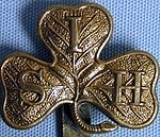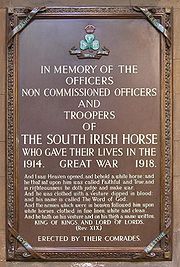
South Irish Horse
Encyclopedia
The South Irish Horse was a Territorial Yeomanry
(Cavalry) regiment of the British Army
. Formed on the 2nd January 1902 as the South of Ireland Imperial Yeomanry. It was renamed as the South Irish Horse from 7 July 1908 and transferred to the Special Reserve (Cavalry). After fighting in the Great War the unit was disbanded in 1922 following the implementation of the Anglo-Irish Treaty
.
 The declaration of war against Germany in August 1914 found the South Irish Horse at summer camp, as was its sister regiment the North Irish Horse
The declaration of war against Germany in August 1914 found the South Irish Horse at summer camp, as was its sister regiment the North Irish Horse
. Together they supplied a composite regiment who acted as GHQ (General Head Quarters) troops in the BEF (British Expeditionary Force) in France, B Squadron from the South Irish Horse and two from the North Irish Horse.
HQ - Artillery Barracks, Limerick
.
A Squadron - Beggars Bush
Barracks, Dublin
B Squadron - Artillery Barracks, Limerick
. (known as "S" Squadron on first deployment to France).
C Squadron - Glen House, Ballyvolane, Cork
.
D Squadron - Beggars Bush Barracks, Dublin
Briefly, the regiment served as separate divisional cavalry squadrons and then as 2 corps cavalry regiments. In September 1917 the officers and men of both regiments were retrained as infantry and formed 7th (South Irish Horse) Battalion Royal Irish Regiment
. The battalion was posted to 49th Infantry Brigade in 16th (Irish) Division. A look at the list of war dead will show 21 men recorded as Killed in Action on 12 December 1917 and a further 9 Died of Wounds by the end of the month. All of these men had previously been in the South Irish Horse.
On 21 March 1918 the battalion was caught in the maelstrom of the German Kaiserschlacht (Kaiser's Battle) Spring offensive. The Official History records that, "2 Coys of 7/Royal Irish posted in forward zone suffered terribly; not a man succeeded in escaping." 77 officers and men of 7th (SIH) Royal Irish Regiment were killed in action that day, 42 were formerly South Irish Horse. 14 officers of the battalion were captured that day 6 of whom were formerly South Irish Horse. By the end of the month over 90 men of the battalion were dead or dying. According to the War Diary of 49th Infantry Brigade the battalion strength on 30 March 1918 was 1 officer and 34 other ranks. The battalion strength on 20 March is not known but a sister battalion (2nd Royal Irish Regiment) in the brigade had a strength of 18 officers and 514 men before the battle and 1 officer and 31 other ranks on 30 March. 15 officers of this battalion were also captured (two of whom were also formerly South Irish Horse).
The regiment was one of the six British Army regiments disbanded in 1922 as a result of the Partition of Ireland
, having only existed for a mere 20 years.
Ypres, 1918 - Courtai - France and Flanders, 1915-18.
The Combined Irish Regiments Association also remains as a source of information and for those who wish to remember the disbanded regiments.
Yeomanry
Yeomanry is a designation used by a number of units or sub-units of the British Territorial Army, descended from volunteer cavalry regiments. Today, Yeomanry units may serve in a variety of different military roles.-History:...
(Cavalry) regiment of the British Army
British Army
The British Army is the land warfare branch of Her Majesty's Armed Forces in the United Kingdom. It came into being with the unification of the Kingdom of England and Scotland into the Kingdom of Great Britain in 1707. The new British Army incorporated Regiments that had already existed in England...
. Formed on the 2nd January 1902 as the South of Ireland Imperial Yeomanry. It was renamed as the South Irish Horse from 7 July 1908 and transferred to the Special Reserve (Cavalry). After fighting in the Great War the unit was disbanded in 1922 following the implementation of the Anglo-Irish Treaty
Anglo-Irish Treaty
The Anglo-Irish Treaty , officially called the Articles of Agreement for a Treaty Between Great Britain and Ireland, was a treaty between the Government of the United Kingdom of Great Britain and Ireland and representatives of the secessionist Irish Republic that concluded the Irish War of...
.
History

North Irish Horse
The North Irish Horse is a yeomanry unit of the British Territorial Army raised in the northern counties of Ireland in the aftermath of the Second Boer War...
. Together they supplied a composite regiment who acted as GHQ (General Head Quarters) troops in the BEF (British Expeditionary Force) in France, B Squadron from the South Irish Horse and two from the North Irish Horse.
- Squadrons
HQ - Artillery Barracks, Limerick
Limerick
Limerick is the third largest city in the Republic of Ireland, and the principal city of County Limerick and Ireland's Mid-West Region. It is the fifth most populous city in all of Ireland. When taking the extra-municipal suburbs into account, Limerick is the third largest conurbation in the...
.
A Squadron - Beggars Bush
Beggars Bush (Dublin)
Beggars Bush is the name of a former barracks on Haddington Road in Dublin, Ireland, as well the surrounding area and a nearby pub.The barracks dates from 1827 and is bordered to the east by Shelbourne Road, which used to be the western bank of the River Dodder.-History:The British Army used the...
Barracks, Dublin
B Squadron - Artillery Barracks, Limerick
Limerick
Limerick is the third largest city in the Republic of Ireland, and the principal city of County Limerick and Ireland's Mid-West Region. It is the fifth most populous city in all of Ireland. When taking the extra-municipal suburbs into account, Limerick is the third largest conurbation in the...
. (known as "S" Squadron on first deployment to France).
C Squadron - Glen House, Ballyvolane, Cork
County Cork
County Cork is a county in Ireland. It is located in the South-West Region and is also part of the province of Munster. It is named after the city of Cork . Cork County Council is the local authority for the county...
.
D Squadron - Beggars Bush Barracks, Dublin
Briefly, the regiment served as separate divisional cavalry squadrons and then as 2 corps cavalry regiments. In September 1917 the officers and men of both regiments were retrained as infantry and formed 7th (South Irish Horse) Battalion Royal Irish Regiment
Royal Irish Regiment (1684-1922)
The Royal Irish Regiment, until 1881 the 18th Regiment of Foot, was an infantry regiment of the line in the British Army, first raised in 1684. Also known as the 18th Regiment of Foot and the 18th Regiment of Foot, it was one of eight Irish regiments raised largely in Ireland, its home depot in...
. The battalion was posted to 49th Infantry Brigade in 16th (Irish) Division. A look at the list of war dead will show 21 men recorded as Killed in Action on 12 December 1917 and a further 9 Died of Wounds by the end of the month. All of these men had previously been in the South Irish Horse.
On 21 March 1918 the battalion was caught in the maelstrom of the German Kaiserschlacht (Kaiser's Battle) Spring offensive. The Official History records that, "2 Coys of 7/Royal Irish posted in forward zone suffered terribly; not a man succeeded in escaping." 77 officers and men of 7th (SIH) Royal Irish Regiment were killed in action that day, 42 were formerly South Irish Horse. 14 officers of the battalion were captured that day 6 of whom were formerly South Irish Horse. By the end of the month over 90 men of the battalion were dead or dying. According to the War Diary of 49th Infantry Brigade the battalion strength on 30 March 1918 was 1 officer and 34 other ranks. The battalion strength on 20 March is not known but a sister battalion (2nd Royal Irish Regiment) in the brigade had a strength of 18 officers and 514 men before the battle and 1 officer and 31 other ranks on 30 March. 15 officers of this battalion were also captured (two of whom were also formerly South Irish Horse).
The regiment was one of the six British Army regiments disbanded in 1922 as a result of the Partition of Ireland
Partition of Ireland
The partition of Ireland was the division of the island of Ireland into two distinct territories, now Northern Ireland and the Republic of Ireland . Partition occurred when the British Parliament passed the Government of Ireland Act 1920...
, having only existed for a mere 20 years.
Battle honours
Loos - Somme, 1916, 1918 - Albert, 1916 - St Quentin - Rosières - Avre -Ypres, 1918 - Courtai - France and Flanders, 1915-18.
Association
The regiment no longer has an association but dependents may still get assistance from the Army Benevolent Fund.The Combined Irish Regiments Association also remains as a source of information and for those who wish to remember the disbanded regiments.
Great War Memorials
- Irish National War Memorial GardensIrish National War Memorial GardensThe Irish National War Memorial Gardens is an Irish war memorial in Islandbridge, Dublin dedicated "to the memory of the 49,400 Irish soldiers who gave their lives in the Great War, 1914–1918", out of over 300,000 Irishmen who served in all armies....
, Dublin. - Island of Ireland Peace ParkIsland of Ireland Peace ParkThe Island of Ireland Peace Park and its surrounding park , also called the Irish Peace Park or Irish Peace Tower in Messines, near Ypres in Flanders, Belgium, is a war memorial to the soldiers of the island of Ireland who died, were wounded or are missing from World War I, during Ireland's...
Messines, Belgium. - Ulster Tower MemorialUlster Tower ThiepvalThe Ulster Tower is a memorial to the men of the 36th Division. The memorial was officially opened on November 19, 1921 and is a very close copy of Helen's Tower which stands in the grounds of the Clandeboye Estate, near Bangor, County Down in Northern Ireland...
Thiepval, France. - Menin Gate Memorial Ypres, Belgium.
External links
- http://combined-irish-regiments-oca.org.uk/
- http://www.1914-1918.net/CAVALRY/sirishhorse.htm
- http://yourarchives.nationalarchives.gov.uk/index.php?title=South_Irish_Horse
- http://southirishhorse.com/
- http://www.waterfordcountymuseum.org/exhibit/web?task=Display&art_id=31&pagenum=2
- Department of the Taoiseach - Irish Soldiers in the First World War
- http://www.irishwarmemorials.ie

